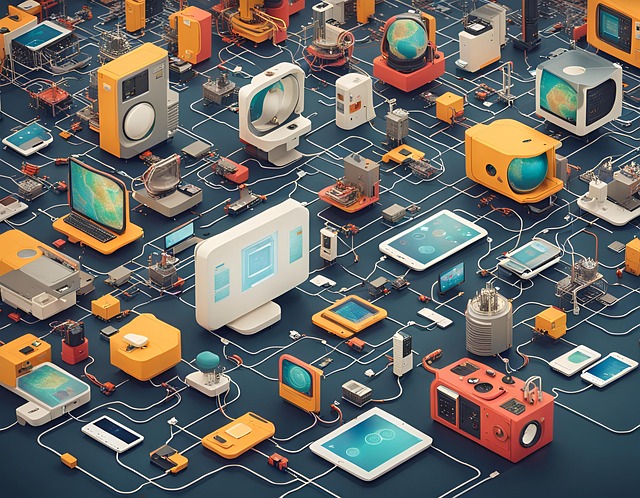AI onboarding workflows revolutionize long-term rental properties by offering personalized, automated solutions through machine learning. These systems adapt to individual preferences, automating tasks like lighting, temperature, and security adjustments based on resident routines. Renters interact with AI interfaces to set up smart home devices, enhancing convenience and understanding of available features. Advanced AI makes these systems more intuitive and responsive, redefining modern living. Successful integration requires seamless execution to satisfy tenants, streamlining initial setup and future interactions through voice commands, automated routines, and predictive analytics. Despite challenges like data privacy and setup costs, the long-term benefits—including improved efficiency, cost savings, and enhanced experiences—make AI a compelling force in real estate.
“In the evolving landscape of rental properties, Artificial Intelligence (AI) integration in smart home systems is revolutionizing long-term rentals. This article explores the seamless transition into AI-powered living spaces, focusing on understanding AI onboarding for new tenants and its benefits. We delve into how streamlined workflows enhance user experience, from initial setup to daily interactions. Additionally, we weigh the challenges and opportunities this technology presents in the rental market, highlighting its potential as a game-changer in property management.”
- Understanding AI Onboarding for Long-Term Rentals
- Integrating Smart Home Systems: A Seamless Experience
- Benefits and Challenges of AI in Rental Properties
Understanding AI Onboarding for Long-Term Rentals

AI onboarding workflows for new renters in long-term rental properties are transforming the way we experience living spaces. These intelligent systems aim to make the transition into a new home smoother and more personalized, leveraging machine learning algorithms to adapt to individual preferences. By understanding user behavior, AI can automate tasks like adjusting lighting, temperature, and security settings based on the resident’s routines.
During the onboarding process, renters interact with AI interfaces that guide them through setting up smart home devices, teaching them how to control various aspects of their environment. This not only enhances convenience but also encourages a deeper understanding of available features. As AI continues to evolve, expect these systems to become even more intuitive and responsive, redefining what it means to live in a modern, tech-integrated home.
Integrating Smart Home Systems: A Seamless Experience

Integrating smart home systems can greatly enhance the rental experience, but it needs to be done seamlessly to ensure satisfaction among tenants. AI-powered onboarding workflows for new renters play a pivotal role in this process. By automating initial setup and configuration, these workflows simplify connecting devices like lights, thermostats, and security cameras to a central control system. This not only reduces the learning curve for users but also allows property managers to pre-program settings tailored to individual preferences or apartment layouts.
A well-designed onboarding experience further streamlines future interactions with the smart home. Voice commands, automated routines, and predictive analytics powered by AI enable tenants to control their environment intuitively. For instance, a renter might set up a routine where lights dim, music plays softly, and the thermostat adjusts based on pre-set schedules or personal preferences. This level of integration fosters a sense of comfort and convenience, transforming the rental unit into a truly modern and inviting space.
Benefits and Challenges of AI in Rental Properties

The integration of Artificial Intelligence (AI) in long-term rental properties offers a plethora of benefits, revolutionizing the way landlords and tenants interact with smart home systems. AI onboarding workflows for new renters can be streamlined, providing a seamless experience from the moment they move in. Virtual assistants powered by AI can guide tenants through setting up their unique system preferences, offering personalized recommendations based on their usage patterns over time. This technology enhances energy efficiency by automatically adjusting lighting and temperature settings, reducing costs and environmental impact. Moreover, AI-driven systems can improve tenant satisfaction by enabling remote monitoring of property conditions, allowing quick issue resolution without physical inspections.
However, challenges exist when implementing AI in rental properties. Data privacy and security are paramount concerns; landlords must ensure tenant information is protected during AI integration. Additionally, the initial setup cost and complexity might deter some property owners and managers, especially smaller operations. Training tenants to use AI-enhanced systems could also be an obstacle, as not all residents may embrace or understand new technology readily. Despite these challenges, the long-term benefits of AI in rental properties, such as improved efficiency, cost savings, and enhanced tenant experiences, make it a compelling and transformative force in the real estate sector.
As we’ve explored, integrating AI into long-term rental properties through smart home systems offers numerous benefits, from enhanced tenant experiences to improved property management. Streamlined AI onboarding workflows for new renters can make these systems more accessible and user-friendly. However, challenges such as data privacy concerns and initial setup costs must be addressed to fully realize the potential of this technology in revolutionizing the rental industry. By overcoming these hurdles, we can create truly modern and efficient living environments that cater to the needs of tenants while optimizing property owners’ operations.
